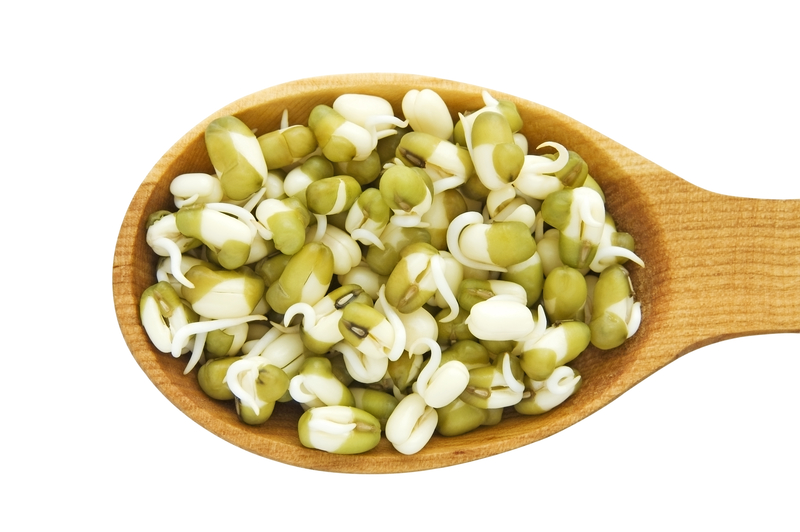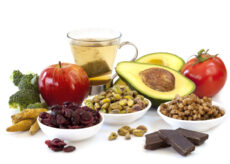What Are Sprouted Foods? And Are Sprouted Foods Healthier?

Is it possible an agricultural happenstance, which modern processing techniques all but eradicated, could be a key to unlocking the greatest benefits from certain foods? Could we be missing out on optimal health by turning our backs on an ancient cultivation technique?
According to the Whole Grains Council, historically, many grains sprouted by accident. Now, modern processing techniques have all but eradicated this naturally-occurring germination process. It’s just within the last few decades that we’ve learned we may be missing out by turning our backs on our sprouting history.
Generally speaking, sprouted foods are cultivated by soaking seeds until germination occurs and a small sprout barely extrudes. Even though sprouting can happen accidentally, mastering the process involves much more than soaking seeds. The germination process involves the right amount of time, temperature, and moisture. Too much moisture can drown the seed and cause it to rot. Too much time can result in the seed becoming a grass, which we humans don’t have the capacity to digest.
Although there’s no regulated definition of sprouted foods, the AACCI (formerly known as the American Association of Cereal Chemists), one of the world’s leading authorities on grains, defines sprouted grains as, “Malted or sprouted grains containing all of the original bran, germ, and endosperm… as long as sprout growth does not exceed kernel length and nutrient values have not diminished.”
What Counts as Sprouted Foods?
While grains are currently the most popular and widely consumed among sprouted foods, any seed, including whole grains, legumes, and nuts, can be sprouted. Here are some examples:
- Wheat
- Barley
- Millet
- Spelt
- Buckwheat
- Brown rice
- Lentils
- Soybeans
- Beans
- Peas
- Chickpeas
- Alfalfa
- Almonds
- Cashews
Are Sprouted Grains Whole Grains?
As you can see, there are many different types of sprouted foods. Having said that, arguably the most readily available and widely consumed are sprouted grains. These are, in fact, whole grains. And there’s no shortage of research—albeit mostly observational studies—suggesting diets rich in whole grains reduce the risk of several chronic diseases. This list includes type 2 diabetes, heart disease, stroke, and certain cancers. Whole grains also appear to have a beneficial impact on weight management and mortality.15,16
Whole grains—and to an even greater effect, sprouted grains—contain dietary fiber (including β-glucan), minerals, vitamins (e.g., B vitamins), and phytochemicals (e.g., antioxidants) that may have a variety of favorable health effects including:17
- Lowering blood pressure
- Lowering blood lipids (e.g., cholesterol)
- Improving insulin sensitivity
- Improving markers of inflammation
- Improving endothelial function
What Are the Nutritional Benefits of Sprouting?
You can think of a seed—whether it’s a whole grain, seed, legume, or nut—as a long-term storage package. One that is specifically designed to lock up all its goodness. Along those lines, the sprouting process is a highly effective key that “unlocks” many of the seed’s nutrients, making them more available to our bodies.1 Sprouting seeds…
- Increases antioxidants. In one study, researchers from Mexico found that sprouting amaranth dramatically increased antioxidant activity by up to 470%, total phenolic compound content by 829%, and total flavonoid content by 213%.2 Numerous other studies have shown similar impressive findings in other grains, such as millet, wheat, and brown rice.3–6 This is important because excessive oxidative stress appears to be the crux of many chronic diseases. Along those lines, observational studies strongly suggest long-term consumption of diets rich in plant polyphenols (i.e., antioxidants) offer protection against development of cancers, cardiovascular diseases, diabetes, osteoporosis, and neurodegenerative diseases.7
- Increases fiber content. On a number of occasions, we’ve talked about the importance of getting enough dietary fiber. Why? Because it can promote digestive health, regularity, heart health, glycemic control, longevity, weight management, and more. Sprouting has been shown to increase the amount of fiber in both brown rice and wheat. In fact, one study showed a threefold increase in the soluble fiber in wheat.6,8,9
- Modulates enzymatic activities. On one hand, sprouting has been shown to inhibit the activity of the enzymes α-amylase and α-glucosidase, which are involved in the breakdown of carbohydrates.3 This is significant because when these enzymes are inhibited, it lowers the glycemic response to a meal. On the other hand…
- Decreases levels of phytic acid. Sprouting has been shown to increase the activity of the enzyme phytase. This enzyme is responsible for breaking down the “antinutrient” phytic acid.4 While there are potential benefits to phytic acid and the “antinutrient” designation may be a bit misleading (albeit accurate), this means that sprouting…
- Enhances bioavailability of certain minerals. Because phytic acid can sequester certain minerals, it reduces their bioavailability. Not surprisingly, since sprouting grains like millet, wheat, and barley enhances phytase activity and reduces phytic acid levels, it also increases the bioavailability of minerals like magnesium, zinc, calcium, iron, sodium, and manganese.4,10
- Enhances the content of folate and other vitamins. Studies have shown that sprouting can increase the folate content in rye and wheat more than threefold.9,11,12 Folate is primarily regarded for its role in the nervous system. And of course, folate deficiency is directly implicated in neural tube defects in infants. Folate also plays a crucial role in the recycling of the potentially toxic compound homocysteine. Along those lines, low folate intakes appear to be related to neurodegenerative diseases and mood disorders.13
- Reduces levels of gluten. A study published in the Journal of Agricultural and Food Chemistry found that sprouting “substantially” reduced the content of gluten in wheat.9 While gluten may not be the devil many make it out to be, this could have significant implications for folks with non-celiac gluten sensitivity. Sprouting has also been shown to reduce levels of prolamins in grains like millet.14
What Are the Health Benefits of Sprouted Foods?
As mentioned above, sprouted grains—which are arguably the most readily available and widely consumed sprouted foods—fall under the umbrella of “whole grains.” Along those lines, the evidence is pretty clear that a higher intake of whole grains is associated with better diet quality, better overall health, and reduced risk of many non-communicable chronic diseases.
Having said that, the research pointed out above suggests sprouted foods may potentially provide an even greater health boost. Along those lines, research specifically done on eating sprouted foods has shown some pretty impressive health benefits:
- Reduce glycemic impact. As mentioned above, sprouting appears to inhibit the activity of key enzymes involved in the breakdown of carbohydrates. You can think of this as a “carb-blocking” effect. Researchers have found that consumption of sprouted-grain bread made with sprouted brown rice led to significant reductions in post-meal blood glucose levels.18,19 This has significant implications on glycemic control, which among many things, impacts one’s risk for type 2 diabetes.
- Improve glycemic control. In one study, Japanese researchers compared the effects of eating white rice or sprouted brown rice twice daily for six weeks. They found “fasting blood glucose, fructosamine, serum total cholesterol, and triacylglycerol levels were favorably improved” on the sprouted brown rice diet but not on the white rice diet. This suggests including sprouted grains can have a favorable impact on glycemic control and other markers of cardiometabolic health compared to refined grains.20
- Improve heart health. As mentioned above, consuming sprouted grains for prolonged periods of time can lead to improvements in blood lipids, such as cholesterol and triglycerides. Additionally, studies in rodents have shown that regular consumption of sprouted foods increases HDL cholesterol (“good” cholesterol), reduces blood pressure, and protects the heart from oxidative stress.21,22
- Improve mood, energy levels, and immunity in nursing mothers. In a study published in the European Journal of Nutrition, Japanese researchers found that breastfeeding mothers who consumed sprouted brown rice daily for two weeks showed significant improvements in feelings of well-being, reductions in feelings of fatigue, and enhancements in immune function compared to nursing mothers who consumed white rice.23Although the participants were breastfeeding women, it’s possible to speculate that similar results might be seen in other populations considering that sprouted foods have more fiber, antioxidants, and folate.
In addition to all that, sprouting has also been shown to improve taste and digestibility.24–26 Imagine that, healthy food that tastes good and doesn’t lead to uncomfortable digestive distress. Sounds like a winner!
How Can I Add More Sprouted Foods to My Diet?
By now, you may be wondering how you can add sprouted foods to your diet. (And if you’re already consuming sprouted foods, you may be thinking, “I told you so.”) According to the Whole Grains Council, there are three main ways to add sprouted foods to your diet.
- You can buy packaged sprouted food products, such as breads, cereals, pastas, etc. For products made with sprouted grains, keep an eye out for the Whole Grains Stamp, as we’ve previously discussed.
- You can enjoy sprouted foods as side dishes (e.g., sprouted brown rice) or as accompaniments (e.g., alfalfa sprouts, bean sprouts).
- You can bake with sprouted food flours.
Even though sprouted foods are increasing in popularity, their availability is still somewhat limited. Here are some of the most popular brands and retailers:
- Angelic Bakehouse
- Food for Life
- Shiloh Farms
- Silver Hills Bakery
- Planet Rice
- Essential Eating Sprouted Foods
- To Your Health Sprouted Flour
- Edme
- Valley Select
Having said that, while the sprouting process appears to increase the quality and digestibility of certain foods, keep in mind that they’re not magical foods. They’re intended to be consumed in appropriate amounts as part of an overall healthy diet and lifestyle. I know that doesn’t sound glamorous. But as the romance around sprouted grains increases, there’s a possibility we’ll see a dramatic increase in the marketability of products made with sprouted grains and seeds (as we did with gluten-free foods and others).
Yet as a food strays further from its natural state and “other” ingredients are added, a good thing can go wrong quite quickly. Consider, for example, the gluten-free craze and how easily “junk” food can be Paleofied or made Keto. Are we just finding alternative ways to eat junk food? Or, are we truly interested in optimizing health through whole foods? I think you know which one should be the correct answer.







